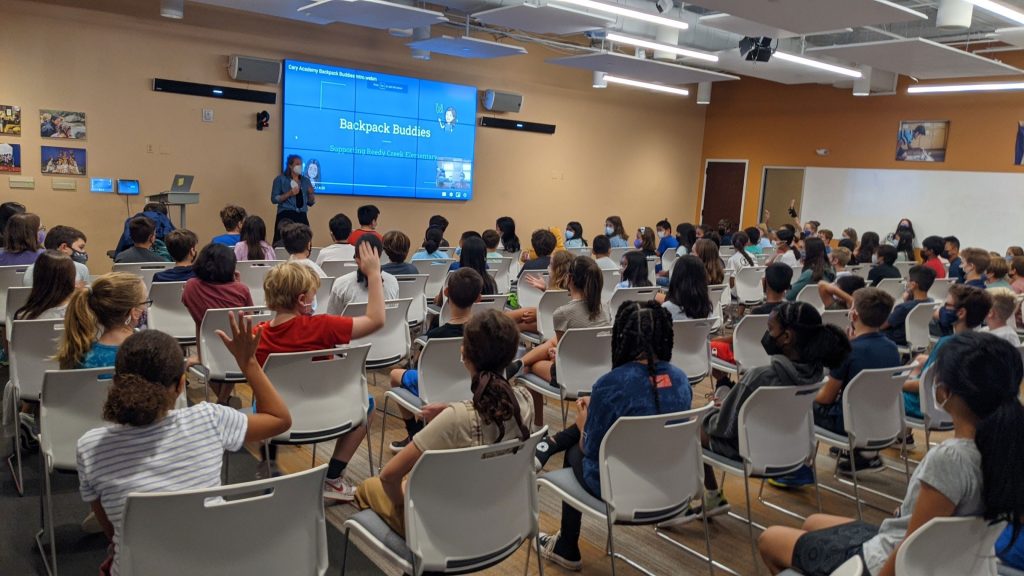A puzzled voice from the back: “Can we just leave our kid home alone?”
Said with a sigh from another seat: “Maybe we don’t need health insurance; it is too expensive.”
A third chimed in, frustration evident: “No, our kid can’t have ice cream. We can’t afford it.”
I sat quietly, watching the wheels turn as our 6th graders maneuvered through the process of SPENT, an online simulator that walks users through a month of spending on a limited budget, of balancing necessary expenses like rent, health insurance and medical care, groceries, utilities, childcare, and more.
Of course, the students knew they should never leave a sick child home alone, but they also knew that their fictional job did not offer the flexibility to take a day off and their childcare funds were . . . well, there were no childcare funds. They understood that they would never want to go to school with dirty clothes, but they also recognized that a laundry mat costs money they did not have.
Our students struggled with these difficult challenges plucked from the real world; impossible choices that must be made. Do you pay high health insurance premiums or risk devastatingly costly emergency medical bills? Do you take a new job with a higher salary but longer hours that increases costly childcare needs? These are, of course, the difficult and nuanced decisions–the realities–faced by many in our own community on a daily basis.
Later, students embarked on field trips to local stores, including Dollar Tree and Walgreens, to see just how far they could stretch their limited grocery budget dollars. New realizations, new questions emerged: where was the fresh produce? How do you eat healthy if you live in an urban food desert? How do you meet your grocery needs if you can only shop at stores where stock is limited and overpriced? Why are there food deserts? Why aren’t grocery stores available to everyone?
Across these activities you could see the thoughts forming, lightbulbs clicking on all over the room. Nebulous concepts were rendered into stark and uncomfortable realizations: not everyone in our community can afford the basics necessary to survive. Many are engaging in impossibly complicated balancing acts simply trying to keep food on the table. Just a half mile down the road, students our ages don’t have adequate access to food.
I watched as students sat in these uncomfortable realities, thinking deeply, realizing that not everyone has their privilege; many children go hungry at night. Importantly, in their newfound empathy and awareness, I saw the initial sparks of resolve, of wanting to be part of a solution.
For me, this is the power of experiential learning: those “lightbulb” moments—transformative epiphanies when students move beyond learning simple facts to understanding complex concepts and systems. And nowhere are these more important than in service learning.
Our service-learning focus in 6th grade is Backpack Buddies, which helps address food insecurity in our community by sharing food with local elementary schoolers. Backpack Buddies is a wonderful and important program, and one supported by many local area schools, often with canned food donation drives.
These drives, organized and led by our Middle School students, are crucially important to our local Backpack Buddies chapter. But, at CA, they are only one piece of the service-learning puzzle; our incredible Service Learning Director, Maggie Grant, is using this program as a springboard to help our students understand that our responsibility to addressing local food insecurity doesn’t begin and end with the donation of a few canned goods.
Instead, we want our students to understand food insecurity—the sad truth that 1 in 5 American children deal with hunger—on a systemic level. We want them to think critically and complexly about the conditions—social, economic, geographic, political, and more—that are creating and exacerbating food insecurity. We want them to develop empathy for those whose experiences are vastly different from their own. And we want to prepare them to use that knowledge thoughtfully, ethically, and in partnership with our community to help create new, better systems that allow everyone to have equitable access to healthy food.
If that seems like a heavy lift for 6th graders, sixth-grade language arts teacher Katie Taylor would like to assure you that it isn’t! Consider these reflections that her students shared with her:
“I learned today that no matter what, people should get enough food; there are invisible challenges for people dealing with low incomes or poverty . . . we can come together to help many hungry people out there.”
“At the store, we realized that a lot of the items we found were not quite as nutritious as we hoped they’d be. Most of the items we found were not friendly to those allergic to nuts!”
A third student wisely reflected that “Having food on the table is harder than it sounds. You can’t just snap…. There are a lot of things that you need to think about.”
As Ms. Taylor says, “these students have all found a lightbulb moment; we’ll work together this year to help them keep the lights on” as we encourage them to look outside themselves, to solve community problems, and to think deeply with empathy.

